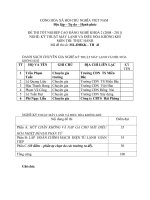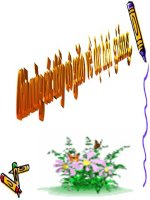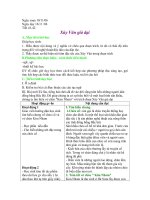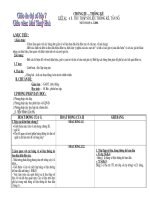PASSAGE 41
Bạn đang xem bản rút gọn của tài liệu. Xem và tải ngay bản đầy đủ của tài liệu tại đây (39.65 KB, 3 trang )
PASSAGE 41
Print media encompasses mass communication through printed material. It includes newspapers,
magazines, booklets and brochures, house magazines, periodicals or newsletters, direct mailers, handbills
or flyers, billboards, press releases, and books.
Newspapers enjoyed the position of the most preferred medium to reach a wider audience until electronic
communication emerged on the media scene. In the early days, newspapers were the only medium that
masses at large depended on, for daily news. A newspaper carries all kinds of communication related to a
variety of topics like politics, socialism, current affairs, entertainment, finance, stocks, etc.
Apart from this, it also includes topics, which are in lighter vein like cartoons, crosswords, Sudoku, movie
reviews, book reviews, puzzles, crosswords, etc. This captivates the imagination and interests of readers
from all age groups. Newspapers are an important platform of mass communication, as they reach every
nook and corner of the world where electronic media fails to reach. It plays a pivotal role in providing
authentic firsthand information, building opinions, updating the knowledge of the reader, and serves as a
good platform for advertisers to promote their products. However, with the emergence of Internet, which
updates information every second, and is just a click away, the popularity of newspapers has reduced.
Magazines are another type of popular culture print media. They usually cater to a specific type of
audience who are looking for information based on a particular subject. Magazines cover a plethora of
topics, like current affairs, business, finance, consumers, gadgets, self-help, luxury, lifestyle, beauty,
fashion, entertainment, travel, etc. Magazines like TIME and Reader's Digest include information, which
is all-pervasive.
The frequency of magazines can be weekly, fortnightly, bi-monthly, quarterly, half-yearly, or yearly.
These magazines are the best forum for advertisers, as they have a niche readership. The readers look for
a specific type of information, say for example, a camera ad in a Gadget magazine will definitely have a
direct brand impact on the reader who wants to buy a camera. Also, the shelf life and brand recall of
magazines is far better than newspapers, which have a short life span.
Question 1. What is the most preferred medium to reach a wider audience now?
A. Newspapers
B. Magazines
C. Public speaking
D. Electronic communication
Question 2. Companies can make use of newspapers to ___________ their products.
A. advertise
B. update knowledge on C. get information about D. build opinions on
Question 3. What makes magazines different from newspapers?
A. They are much thicker than a newspaper.
B. They aim at a particular group of readers.
C. They are more colorful and attractive.
D. They cover wider topics than the latter.
Question 4. What does the word “niche readership” refer to?
A. Readability and literacy
B. Specialized regular readers
C. Reader leaders
D. Relationships with readers
Question 5. According to the passage, compared with newspapers, magazines are ___________.
A. more interesting
B. better selling
C. more colorful
D. more effective
Page 1
ĐÁP ÁN
1-D
2-A
3-B
4-B
5-B
LỜI GIẢI CHI TIẾT
Question 1:
Phương tiện ưa thích nhất để tiếp cận đối tượng rộng hơn bây giờ là gì?
A. Báo chí B. Tạp chí
C. Nói trước cơng chúng D. Giao tiếp điện tử
=> Dẫn chứng: Newspapers enjoyed the position of the most preferred medium to reach a wider
audience until electronic communication emerged on the media scene.
Dịch: Báo chí là vị trí của phương tiện ưa thích nhất để tiếp cận đối tượng rộng hơn cho đến khi truyền
thông điện tử xuất hiện trên các phương tiện truyền thông.
Question 2:
Các cơng ty có thể sử dụng các tờ báo để ___________ sản phẩm của họ.
A. quảng cáo
B. cập nhật kiến thức về
C. lấy thông tin về
D. xây dựng ý kiến về
=> Dẫn chứng: It plays a pivotal role in providing authentic firsthand information, building opinions,
updating the knowledge of the reader, and serves as a good platform for advertisers to promote their
products.
Dịch: Nó đóng một vai trị quan trọng trong việc cung cấp thơng tin trực tiếp đích thực, xây dựng ý kiến,
cập nhật kiến thức của người đọc và đóng vai trị là nền tảng tốt để các nhà quảng cáo quảng bá sản phẩm
của họ.
Question 3:
Điều gì làm cho tạp chí khác với báo?
A. Chúng dày hơn nhiều so với một tờ báo.
B. Họ nhắm đến một nhóm độc giả cụ thể.
C. Chúng có nhiều màu sắc và hấp dẫn hơn.
D. Chúng bao gồm các chủ đề rộng hơn so với sau này.
=> Dẫn chứng: Magazines are another type of popular culture print media. They usually cater to a
specific type of audience who are looking for information based on a particular subject.
Dịch: Tạp chí là một loại phương tiện truyền thơng in văn hóa phổ biến. Họ thường phục vụ cho một loại
đối tượng cụ thể đang tìm kiếm thông tin dựa trên một chủ đề cụ thể.
Question 4:
Từ “niche readership” có nghĩa là gì?
A. Khả năng đọc và biết chữ
B. Độc giả thường xuyên
C. Lãnh đạo độc giả
D. Mối quan hệ với độc giả
=> Dẫn chứng: These magazines are the best forum for advertisers, as they have a niche readership. The
readers look for a specific type of information, say for example, a camera ad in a Gadget magazine will
definitely have a direct brand impact on the reader who wants to buy a camera.
Page 2
Dịch; Những tạp chí này là diễn đàn tốt nhất cho các nhà quảng cáo, vì họ có một lượng độc giả thích
hợp. Các độc giả tìm kiếm một loại thơng tin cụ thể, ví dụ như quảng cáo máy ảnh trên tạp chí Tiện ích
chắc chắn sẽ có tác động thương hiệu trực tiếp đến người đọc muốn mua máy ảnh.
Question 5:
Theo đoạn văn, so với báo, tạp chí là ___________.
A. thú vị hơn
B. bán chạy hơn
C. nhiều màu sắc hơn
D. hiệu quả hơn
=> Dẫn chứng: Also, the shelf life and brand recall of magazines is far better than newspapers, which
have a short life span.
Dịch: Ngoài ra, thời hạn sử dụng và thu hồi thương hiệu của các tạp chí tốt hơn nhiều so với các tờ báo có
tuổi thọ ngắn.
Page 3









